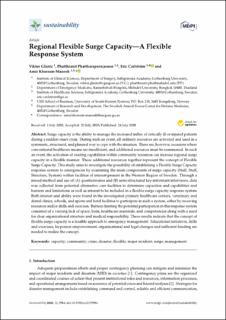| dc.contributor.author | Glantz, Viktor | |
| dc.contributor.author | Carlström, Eric | |
| dc.contributor.author | Khorram-Manesh, Amir | |
| dc.contributor.author | Phattharapornjaroen, Phatthranit | |
| dc.date.accessioned | 2021-03-12T10:18:01Z | |
| dc.date.available | 2021-03-12T10:18:01Z | |
| dc.date.created | 2020-09-25T14:15:15Z | |
| dc.date.issued | 2020 | |
| dc.identifier.citation | Glantz, V., Phattharapornjaroen, P., Carlström, E., & Khorram-Manesh, A. (2020). Regional Flexible Surge Capacity—A flexible response system. Sustainability, 12(15). | en_US |
| dc.identifier.issn | 2071-1050 | |
| dc.identifier.uri | https://hdl.handle.net/11250/2733100 | |
| dc.description.abstract | Surge capacity is the ability to manage the increased influx of critically ill or injured patients during a sudden onset crisis. During such an event, all ordinary resources are activated and used in a systematic, structured, and planned way to cope with the situation. There are, however, occasions where conventional healthcare means are insufficient, and additional resources must be summoned. In such an event, the activation of existing capabilities within community resources can increase regional surge capacity in a flexible manner. These additional resources together represent the concept of Flexible Surge Capacity. This study aims to investigate the possibility of establishing a Flexible Surge Capacity response system to emergencies by examining the main components of surge capacity (Staff, Stuff, Structure, System) within facilities of interest present in the Western Region of Sweden. Through a mixed-method and use of (A) questionnaires and (B) semi-structured key-informant interviews, data was collected from potential alternative care facilities to determine capacities and capabilities and barriers and limitations as well as interest to be included in a flexible surge capacity response system. Both interest and ability were found in the investigated primary healthcare centers, veterinary and dental clinics, schools, and sports and hotel facilities to participate in such a system, either by receiving resources and/or drills and exercises. Barriers limiting the potential participation in this response system consisted of a varying lack of space, beds, healthcare materials, and competencies along with a need for clear organizational structure and medical responsibility. These results indicate that the concept of flexible surge capacity is a feasible approach to emergency management. Educational initiatives, drills and exercises, layperson empowerment, organizational and legal changes and sufficient funding are needed to realize the concept. | en_US |
| dc.language.iso | eng | en_US |
| dc.rights | Navngivelse 4.0 Internasjonal | * |
| dc.rights.uri | http://creativecommons.org/licenses/by/4.0/deed.no | * |
| dc.title | Regional Flexible Surge Capacity – A Flexible Response System | en_US |
| dc.type | Peer reviewed | en_US |
| dc.type | Journal article | en_US |
| dc.description.version | publishedVersion | en_US |
| dc.rights.holder | © 2020 by the authors. | en_US |
| dc.source.volume | 12 | en_US |
| dc.source.journal | Sustainability | en_US |
| dc.source.issue | 15 | en_US |
| dc.identifier.doi | https://doi.org/10.3390/su12155984 | |
| dc.identifier.cristin | 1833513 | |
| dc.source.articlenumber | 5984 | en_US |
| cristin.ispublished | true | |
| cristin.fulltext | original | |
| cristin.qualitycode | 1 | |

